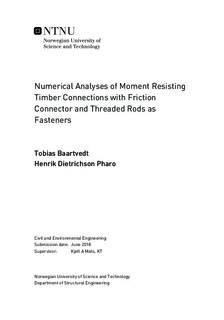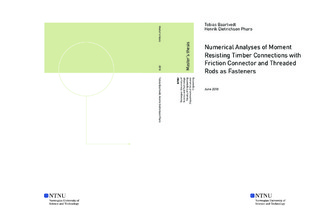| dc.description.abstract | This Master thesis is a continuation of an ongoing study on rigid beam-to-column connections in timber structures using long threaded rods as fasteners. As part of the research project Wood frame solutions for free space design in urban buildings, its objective has been to develop a connection with moment resisting qualities that is easy to assemble on site. The main focus of the thesis has been to achieve as high rotational stiffness as possible, while still keeping the solution practical. This has been done through numerical analyses.
Separate threaded rods in the beam and the column was used. A T-profile was connected to the rods in the beam and two L-profiles were connected to the rods in the column with a small gap between them. The web of the T-profile was placed in the gap between the L-profiles, before two prestressed bolts tied the connection together. Numerical analyses were done to improve the different components of the connection.
For optimizing the rod-to-grain angles in the timber elements, a more detailed modeling technique was carried out. Analyses resulted in the rod-to-grain angle in the beam to be changed from 5° to 10°, as this gave a higher rotational stiffness. A rod-to-grain angle of 75° in the column gave the second highest rotational stiffness with 7850 kNm/rad, and this solution was considered the most practical. The configuration with the highest rotational stiffness had a combination of 55° and 70° rod-to-grain angle in the column and achieved a rotational stiffness of 9188 kNm/rad. However, this solution was considered less practical.
The new design with the L- and T-profile made great improvements with regards to practicality in the assembly phase, compared to solutions in previous theses. The rotational stiffness must be further improved but shows great potential. Detailed analyses of the connection showed that the threaded rods in the column was the weakest component, and further development of the connection should therefore focus on improving this component. | |

